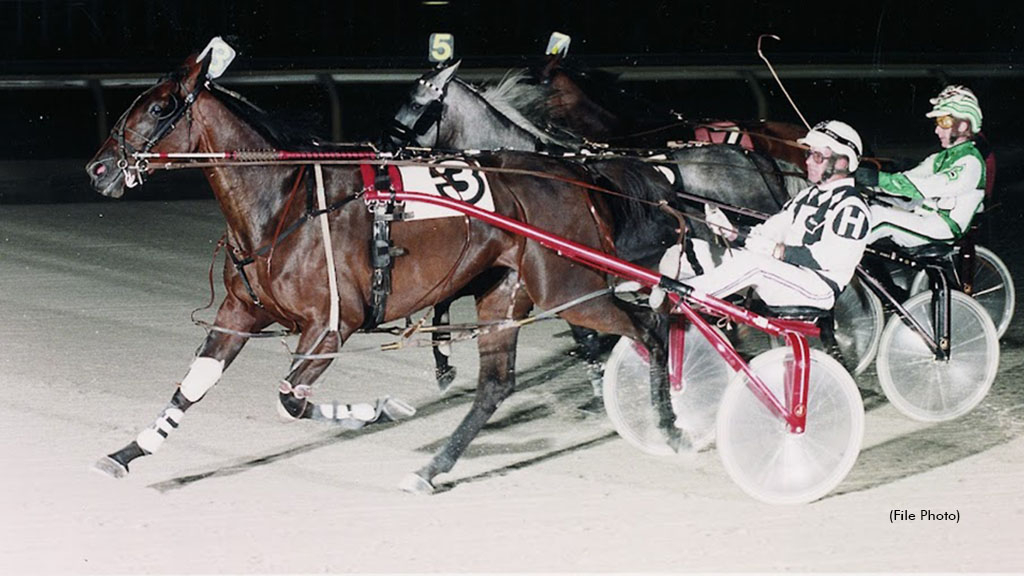
The Ontario Sires Stakes (OSS) is celebrating its 50th anniversary season this year with special anniversary dates at tracks around the province where fans will be able to watch OSS Gold or Grassroots and Prospect Series races, view memorabilia from seasons past, enjoy giveaways and more. Don’t miss the next celebration date as the OSS tour heads to Hiawatha Horse Park on Saturday Sept.7, where you will be able to take in Grassroots action.
When Hiawatha Horse Park opened as part of the Ontario racing scene in 1988, the OSS was already in its 15th season of competition. The new track, which opened on Canada Day, was off to a good start as more than 4,500 fans showed up for the opener. It was, perhaps, fitting that the first race held at the new venue was won by a local horse named In My Shadow, locally owned by Dennis & Don VanDerVeeken and driven to victory by Jim Ainsworth of Petrolia, Ont. Jim's father and grandfather were members of a family that had raced horses dating back several decades. Jim’s father, Larry, was part of the ownership group of this new track when it first opened.
The track operated for some time before all of the plant’s facilities were completed. The official opening was finally held on Sept. 9. A gathering of 2,800 fans attended the kickoff night of a weekend of opening celebrations. The clubhouse, which featured an 856-seat dining room, was filled to capacity.
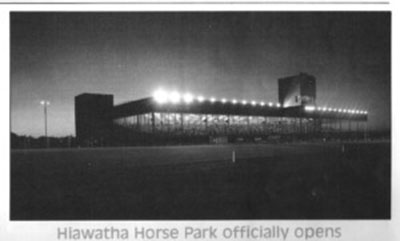
A view of the brand-new Hiawatha grandstand as the track opened in 1988 (Canadian Sportsman photo).
When this track was designed and built, on-site stabling was still provided. Originally five barns were part of the facility as well as a paddock near the grandstand. As time passed and needs changed, the paddock location moved to the backstretch. Also, the long-standing tradition of track stabling was discontinued a number of years ago.
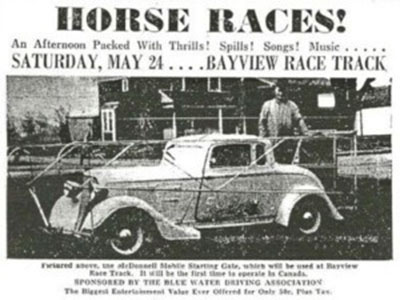
Caption read: Featured above, the McDonnell Mobile Starting Gate, which will be used at Bayview Race Track. It will be the first time to operate in Canada. Sponsored by The Bluewater Driving Association. The biggest entertainment value ever offered for only 50 cents plus tax.
An important piece of early harness racing history was recorded at the old Sarnia track located a few miles from this location, many years prior to the modern era.
In May of 1947, the mobile starting gate made its first appearance at that long-ago closed track. It was designed and built by a gentleman named Tom McDonnell of Hamilton, Ont. It was used to start the Sarnia race day and was an immediate success. The introduction of the mobile starting gate is said to be one of the greatest innovations in the sport and has been used now for well over 75 years.
It’s interesting to note that the Hiawatha track at the time of its opening was the only facility in Canada other than Ottawa’s Rideau Carleton to feature the collapsible hub rail. Today, hub rails usually exist only in old photographs.
The Hiawatha track and its management has remained progressive in its approach over the years and still draws fairly large crowds for live racing. Because of its location near a U.S. border crossing, it’s been able to attract an international audience.
At one time, harness racing in Michigan was a very popular sport, but with the recent closing of its last major track, Northville Downs, the state is without live racing. A short trip across the Bluewater Bridge to Sarnia, however, still provides Michiganders with the opportunity to stay involved.
Though Hiawatha wasn’t an original OSS host track, it can now boast a 35-year attachment to this popular series.
OSS Scrapbook Memories
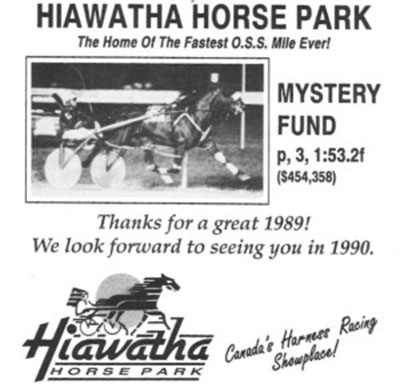
In 1989, the Hiawatha track had already achieved quite a mark of distinction in just its second year of operation. Despite the many races and seasons of OSS competition, Hiawatha became “Home of the Fastest OSS Mile Ever.”
That honour went to Mystery Fund and driver Bill Gale for recently passed trainer Bob McIntosh.
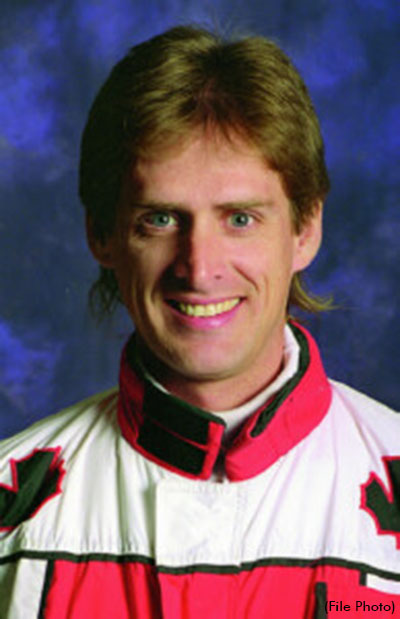
Jim Ainsworth, from nearby Petrolia, pictured above, was a longtime competitor in OSS action and was associated with many top colt performers.
In 1995, he won his first of three consecutive Johnston Cup championships presented to the top OSS trainer of the year. His accomplishment back then marked the first time that anyone had won three Cups.
A few of his top OSS horses were Cathedra, Heatherjeankillean, Superstar Killean, Beau Jim and many more. Jim and his father, Larry, had great success with horses sired by Run The Table and speak highly of the McNiven brothers, Jack and the late Don, whose Killean Acres bred and raised many of their successful performers.
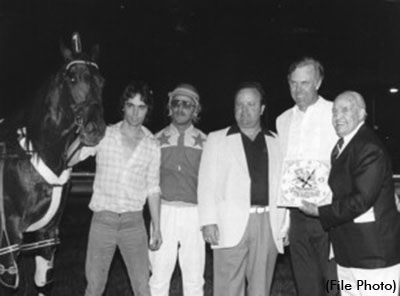
In 1979, Dangerfield Bruce led the three-year-old pacing colts and geldings division in earnings that season with $78,772. He was owned by Dave Morrissey and David Oud, second and third from right. The driver is Harold Stead and the groom was from the John Burns stable.
As a three-year-old, this son of Armbro Nadir earned just over $180,000 thanks in part to money earned in OSS action.
Presenting a trophy is legendary hockey figure King Clancy, once of the Toronto Maple Leafs.
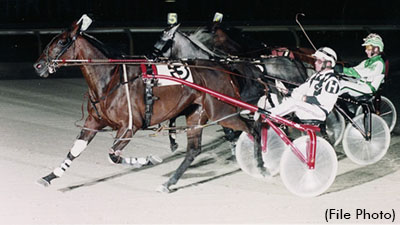
Cathedra (3) is shown above in a winning effort during the 1985 season.
She was nothing short of sensational in her two-year-old season, winning 14 of 16 starts and banking $435,153.
With Ken Hardy driving, she swept all five of her Ontario Sires Stakes Gold Series Finals, becoming the first filly ever to accomplish that feat and, in the process, became the richest two-year-old in OSS history at the time. She also added the Canadian Breeders Championship to her resume of wins.
This daughter of Run The Table was certainly one of the most accomplished performers in the now-long history of the OSS. Bred by Tymal Farms of Oldcastle, Ont., Cathedra was campaigned by trainer Larry Ainsworth and was a $32,000 purchase for partners Martwest Racing Stable of Mississauga, Ont., Ross Holmes of Ilderton, Ont., and Graham Chambers Ltd. of Bothwell, Ont.
She eventually became a member of both the U.S. and Canadian Halls of Fame. And as sensational as she was on the track, her career as a broodmare was even more spectacular.
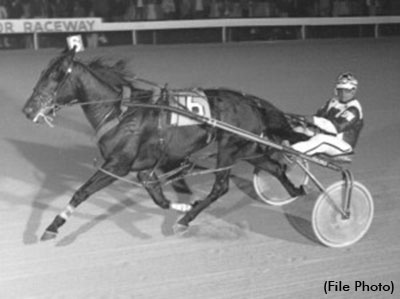
Daisy Harbor breezes to victory for Dave Wall.
In 1991, one of the great single-season performances in the OSS took place as the three-year-old filly pacer Daisy Harbor went undefeated for the entire season. While she didn’t go undefeated in all of her starts that year, the daughter of Coal Harbor was never defeated in 13 OSS engagements. She also became the fastest Canadian-bred filly of all time when she took a time trial mark of 1:53.3 for driver Doug Brown at Lexington. Her earnings in the Sires Stakes competition totalled $111,487.
After a short but successful freshman campaign, the filly was sold in a private deal to well-known sportsman John Grant of Hornby, Ont. She was turned over to a then-young trainer named Scott McEneny, who managed her highly successful three-year-old campaign.
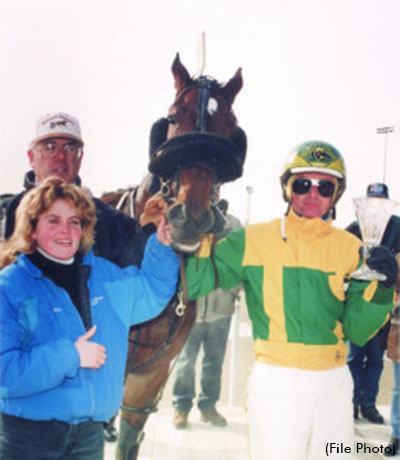
Master Barney and driver Steve Condren appear in the winner’s circle along with owner Bruce Saunders and caretaker Wendy Hoffman. Take note of the cap with the words “Master Barney.”
This pacing colt was an outstanding performer at age three in 1997. In late July and into August, he paced back-to-back wins in 1:51 and 1:51.4 and was second in 1:52.1 in OSS action. Trainer Saunders was not a regular on the Ontario circuit, but when he did participate he was often successful.
Saunders, a U.S.-based trainer, posted his first million-dollar season in 1997 and enjoyed 14 consecutive million-dollar campaigns (topping $2 million four times) beginning in 2000. From 1998 through 2011, he ranked among the top 10 trainers in wins at The Meadowlands on seven occasions and was 11th three times.
(Robert Smith / Ontario Racing)

